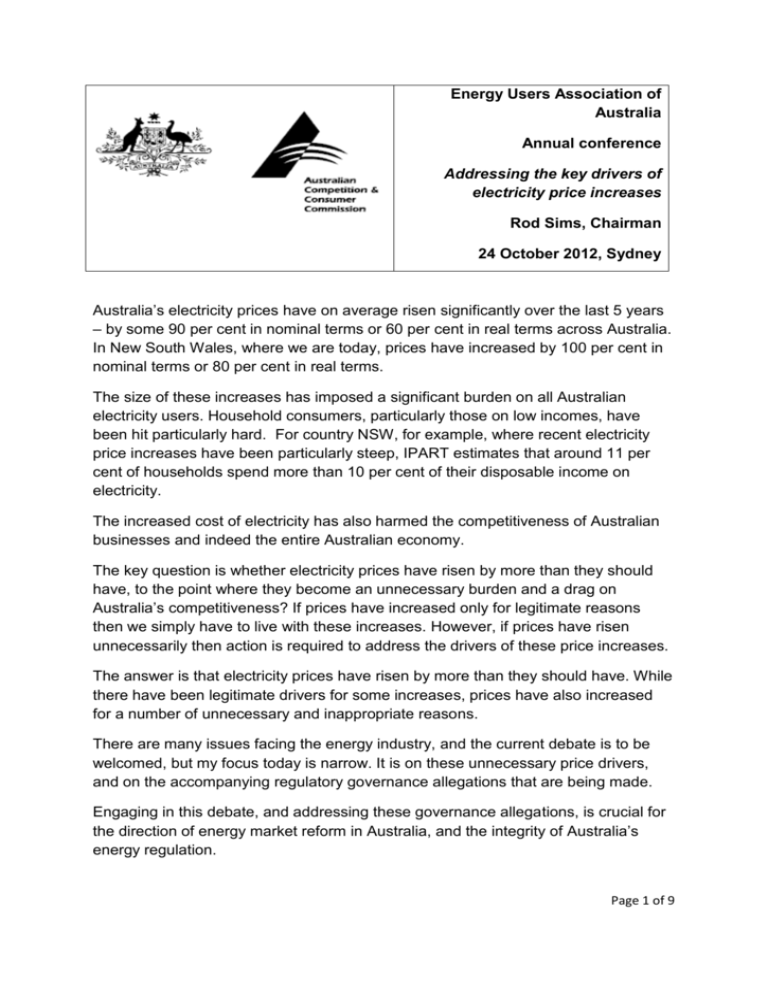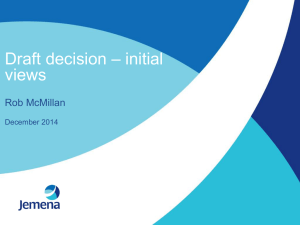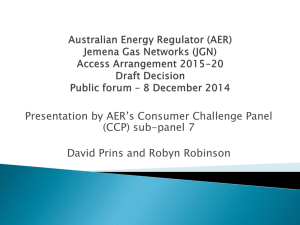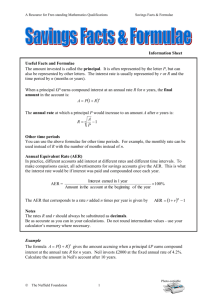Energy Users Association of Australia Annual conference
advertisement

Energy Users Association of Australia Annual conference Addressing the key drivers of electricity price increases Rod Sims, Chairman 24 October 2012, Sydney Australia’s electricity prices have on average risen significantly over the last 5 years – by some 90 per cent in nominal terms or 60 per cent in real terms across Australia. In New South Wales, where we are today, prices have increased by 100 per cent in nominal terms or 80 per cent in real terms. The size of these increases has imposed a significant burden on all Australian electricity users. Household consumers, particularly those on low incomes, have been hit particularly hard. For country NSW, for example, where recent electricity price increases have been particularly steep, IPART estimates that around 11 per cent of households spend more than 10 per cent of their disposable income on electricity. The increased cost of electricity has also harmed the competitiveness of Australian businesses and indeed the entire Australian economy. The key question is whether electricity prices have risen by more than they should have, to the point where they become an unnecessary burden and a drag on Australia’s competitiveness? If prices have increased only for legitimate reasons then we simply have to live with these increases. However, if prices have risen unnecessarily then action is required to address the drivers of these price increases. The answer is that electricity prices have risen by more than they should have. While there have been legitimate drivers for some increases, prices have also increased for a number of unnecessary and inappropriate reasons. There are many issues facing the energy industry, and the current debate is to be welcomed, but my focus today is narrow. It is on these unnecessary price drivers, and on the accompanying regulatory governance allegations that are being made. Engaging in this debate, and addressing these governance allegations, is crucial for the direction of energy market reform in Australia, and the integrity of Australia’s energy regulation. Page 1 of 9 Let me explain by making three points. 1. There have been a number of unnecessary and inappropriate drivers of electricity prices that Australia must address. 2. The debate about how to address these unnecessary price drivers has recently developed a frustrating and worrying line of argument; we may miss the chance to deal effectively with the real issues. 3. We need to revisit the original Hilmer logic for our current regulatory structure; today’s debate shows that logic is, if anything, more relevant today. I will now address each point in turn. 1. THERE HAVE BEEN A NUMBER OF UNNECESSARY AND INAPPROPRIATE DRIVERS OF ELECTRICITY PRICES THAT AUSTRALIA MUST ADDRESS. There have been a range of reasons for recent price increases. Rising generation costs, rising retail costs and the costs of meeting green schemes have all played a part. Thankfully the excessive subsidies for solar panels, which have been very costly for consumers, are now being lowered. The rising costs of the electricity network, however, have been the main contributor to price increases in all states, accounting for between 40 – 50 per cent of the price increases over the past five years. Many factors have driven these increased network costs. The need to replace ageing equipment and meet rising peak demand have, for example, driven particular network investment across the market. There were, however, three key factors driving prices higher than necessary – weaknesses in the rules that set out how the Australian Energy Regulator (AER) must regulate electricity networks, the process by which businesses can appeal the AER’s regulatory decisions, and changes to reliability standards. i. Rules for regulating networks Prior to 2005, the process for setting revenues for energy network businesses was similar to that observed in other network businesses. The regulator would consider submissions from the business about its revenue requirements, consider submissions from interested parties, undertake its own analysis of this information, and form a judgment on the revenue the business required to efficiently provide network services. Starting with the Australian Energy Market Commission’s (AEMC’s) development of the chapter 6A rules for transmission regulation in 2005 and 2006, there was a Page 2 of 9 fundamental shift in this approach. There was a change to a ‘propose respond’ model where the AER was required to accept ‘reasonable’ proposals, and could only amend proposals to the ‘minimum extent necessary’ to enable them to be approved. Given the wide range of what is ‘reasonable’, there was little ability for the regulator to deal with excessive forecasts. The rules also place a large evidentiary burden on the regulator. The rules that the AER must follow when setting energy network prices are unique I am not aware of any other regulatory model in operation in the world today which makes the proposals of the monopoly businesses so central to the process, or so restricts the ability of the regulator to set independent forecasts of the allowable rate of return, or of required expenditure. ii. Limited merits review The Limited Merits Review Regime was introduced in 2008 as a mechanism to review regulatory decisions. In practice, however, this regime has not operated as a ‘review’ of the regulator’s decision. Merits review has not focused on whether the regulator’s overall decision provides network businesses with sufficient revenues to efficiently supply energy services. Rather, merits review has allowed businesses to ‘cherry pick’ one or two issues from what inevitably is a balanced decision weighing hundreds of complex issues, some of which would have favoured the network businesses. The decisions of the review body, the Australian Competition Tribunal, have increased the money recovered from customers by approximately $3 billion. iii. Reliability standards: Higher reliability standards, particularly in NSW and Qld, led to large increases in investment spending costs for an inevitably modest reliability gain. These higher reliability standards were not supported by a robust cost/benefit analysis – there was no assessment of the trade off between investment and reliability. Subsequent work by the AEMC has concluded that, in the case of NSW distribution, a relatively small reduction in reliability can lead to a reduction of hundreds of millions of dollars in the investment required by electricity distribution networks. It is important to stress that in mentioning these three price drivers that this is not an argument about “gold plating”, which is a term I have never used. It is instead about how to appropriately regulate the revenues and therefore profits of monopoly businesses, and the lack of sensible processes in relation to the setting of network standards. Page 3 of 9 There are processes underway that can begin to address these problems. The AEMC’s draft rule change proposal on network regulation can lead to a significant improvement to the rules for setting prices for energy network businesses. The rule change proposal gives the regulator greater scope to deal with inflated forecasts.. There has also been a review of the current Limited Merits Review regime. The Review Panel’s report noted significant flaws in the regime – in particular, that the current merits review arrangements encourage businesses to ‘cherry pick’ elements of regulatory decisions, are overly legalistic, and have not taken the interests of key stakeholders, particularly consumers, into account. Overall the Panel’s recommendations take us in the right direction, but my view is that the Australian Competition Tribunal is still the appropriate review body. In relation to reliability standards, the AEMC’s reviews of distribution reliability outcomes and standards are a good start. The AEMC’s work has highlighted the significant investment savings that can be made for modest incremental reductions in reliability. But ultimately the regulatory process is the best place to address the ‘price – reliability’ trade off, and the consumer’s willingness to pay. There are also good initiatives designed to facilitate more active demand side participation in the market, particularly the Power of Choice review, and to empower energy consumers. The need to promote the interests of energy consumers in the next wave of reform is a critical issue – and one that is a recurring theme in much of what I am discussing today which, of course, is of great relevance to the Energy Users Association of Australia (EUAA). 2. THE DEBATE ABOUT HOW TO ADDRESS THESE UNNECESSARY PRICE DRIVERS HAS RECENTLY DEVELOPED A FRUSTRATING AND WORRYING LINE OF ARGUMENT; WE MAY MISS THE CHANCE TO DEAL EFFECTIVELY WITH THE REAL ISSUES. I see two schools of thought on these particular issues. The first targets the root causes of the unnecessary price increases we have seen over the past five years. This approach focuses on addressing the deficiencies in the electricity rules and reliability settings to ensure that consumers pay no more than necessary for a reliable electricity supply. Fundamental to this approach is the need to ensure that the rule changes and the other reforms are not ‘box ticking’ exercises, but rather are followed through with a strong focus on effective implementation. Page 4 of 9 The second seeks to blame the electricity price increases on the regulator. This line of argument deflects from the very real problems I highlighted earlier – problems with the rules, problems with merits review and problems resulting from stricter state reliability standards. This is a deeply frustrating and worrying aspect of the current debate. First, it is strange indeed to argue that somehow the higher than necessary network prices are due to deficiencies with the AER. The rules mandate a propose/respond model. It is the industry which proposes, in effect, the prices increases; the AER’s intervention has in the past seen price rises significantly lower than those sought. Second, consider the “lead” in the AER’s saddle bags as it has sought to carry out its role. The propose-respond model in the rules restricts the AER from making its own independent assessment of a network business’s expenditure requirements. Instead, it must accept a network business’s proposals if they ‘reasonably reflect’ the efficient costs of a prudent operator. The evidentiary burden is on the AER to prove a forecast is not efficient or prudent, and the rules encourage businesses to submit forecasts at the high end of a ‘reasonable’ range. There is also significant prescription in the rules around determining various rate of return parameters, with limits on the ability of the AER to focus on the overall rate of return. This approach has, for example, required the AER to estimate a debt allowance using benchmarks that do not reflect how the sector actually manages its debt, resulting in significantly higher prices for consumers. More “lead” is provided by a merits review regime that allows businesses to ‘cherry pick’ elements of the AER’s decisions. For example, the AER made a decision based on sound financial principles widely applied by other regulators – assessing the financial markets over a 20 day period close to the decision date. The NSW networks had proposed earlier sampling periods, closer to the date of high interest rate costs in the post –GFC turmoil of financial markets. The Tribunal’s interpretation of the rules meant that businesses were able to pick their preferred period, resulting in additional charges to NSW customers of nearly $2 billion. Further “lead” in the saddle bag has been provided by the decisions in Queensland and New South Wales to make networks meet higher reliability standards. The AER was required to approve the spending required to meet these increased reliability standards – it had no ability to review the appropriateness of the increased standards. The CAPEX resulting from increased reliability standards was significant. In Queensland, for example, the level of reliability CAPEX required in the distribution Page 5 of 9 network more than doubled from one five-year period to the next – but for a relatively modest reliability gain. As another example, AEMO has argued that over $1billion of distribution capital expenditure could potentially be deferred without any detrimental effect to current reliability levels. Third, and of most concern, is the potential for this debate over regulator governance to distract attention from the real issues. Proposed changes to address the unnecessary price drivers are a ‘work in progress.’ Nothing has been finalised. Any changes to the rules need successful implementation by the regulator. Changing the regulator has the potential to damage regulatory continuity and threaten this implementation. The debate about regulatory governance structures highlights the continued importance of having a truly independent electricity regulator. What I mean by independent is a regulator that is independent of government and independent of the industry it seeks to regulate. The AER cannot be more independent than it is now. The AER makes decisions in relation to its functions under the relevant electricity and gas legislation. It is in a central agency, in a neutral portfolio, and with the strength and standing that comes from being a part of Australia’s competition, consumer, telecommunications and general economic regulator. The AER, similarly to the ACCC, recognises that constructive engagement with all stakeholders – industry, consumers and policy makers - is fundamental to effective economic regulation. However, the main complaint I hear from some in industry is that the AER is part of an entity that is too focussed on the interests of consumers. The AER should be so focused. Its mandate, as it is for the ACCC, is to work in the long run interests of consumers. Further, I would argue that, rather than consumer interests playing a reduced role, we need to enhance the role of consumers in the regulatory processes, as the Energy Users Association of Australia (EUAA) is also advocating. A range of recent reviews – such as the AEMC rule change, the review of Limited Merits Review, and the Productivity Commission draft report released last week – have made similar arguments. Keeping the energy regulator within the national competition and consumer protection agency is the best way of promoting the long run interests of consumers in the energy market. And of most importance, let’s not forget that it was the AER, along with IPART, as independent regulators, who highlighted the real problems driving higher electricity prices. It was the AER who took the lead in proposing changes to address deficiencies in the rules. Governments generally, both Commonwealth and State, Page 6 of 9 were slow to recognise the problem. In some instances, governments had to navigate the difficult trade-offs between their interests as asset owners and their interest in seeing appropriate electricity prices for their citizens. If the AER was less independent and more responsive to industry, we may not have seen the regulator-led proposals to address all of these deficiencies. It is difficult to see how making the industry regulator less independent and more responsive to industry can be in the long term interest of electricity consumers. 3. WE NEED TO REVISIT THE ORIGINAL HILMER LOGIC FOR OUR CURRENT REGULATORY STRUCTURE; TODAY’S DEBATE SHOWS THAT LOGIC IS, IF ANYTHING, MORE RELEVANT TODAY. The 1993 Hilmer Report considered very carefully what type of regulatory institution would be required to administer the competition policy reforms whilst minimising the costs of regulation in terms of both compliance costs and the risk of regulatory error. Hilmer strongly supported the establishment of a national independent statutory authority (that came to be the ACCC) with economy-wide responsibility for economic regulation in addition to competition law and consumer protection. To quote the Hilmer report “...there are sufficient common features between access issues in the key network industries to administer them through a common body. As well as the administrative savings involved, there are undoubted advantages in ensuring regulators take an economy-wide perspective and have sufficient distance from particular industries to form objective views on often difficult issues.” 1 This quote picks up on a few of the advantages that Hilmer saw – an economy wide perspective, regulatory consistency, less risk of ‘industry capture’, and administrative savings. Hilmer also saw significant benefits in developing a regulatory institution with a focus on competition as the unifying theme. Almost 20 years on, Hilmer’s logic is still compelling. Indeed, in many respects the case for a combined regulator is stronger today than in the early 1990’s. Technological change, consumer expectations, liberalised markets and the scope and complexity of economic regulation requires an extremely high level of coordination between the regulatory, competition and consumer protection functions. The current model whereby the coordination is internalised provides a highly effective and efficient way of managing this task. 1 National Competition Policy, Report by the independent Committee of Inquiry, August 1993, page 327 Page 7 of 9 Some of the key benefits of the current ACCC/AER model include the following: The model facilitates consistency of decisions across sectors, thereby avoiding distortions in investment decisions based on different regulatory approaches. Other countries have had to develop umbrella organisations to bring the different regulators together to exchange information and coordinate for consistency (for example, Germany). The model fosters a ‘pro-competitive’ rather than a ‘regulatory’ culture. This was a fundamental argument supporting the model arising from the Hilmer Review. Separating the competition or anti-trust elements from the economic regulatory functions risks moving the focus from the important competition objective for economic regulation. The ACCC is able to use industry specific knowledge gained through the AER’s regulatory functions to inform decision making in competition law issues. For example, the expertise of the AER is heavily drawn upon in considering energy mergers, authorisations and enforcement actions in the energy sector. In a similar vein, network regulation is a core competency of the ACCC. Similar analytical approaches and thinking are required in all regulation (cost of capital, regulatory asset base, related parties, incentive mechanisms, assessment of demand forecast, and consideration of operating and capital expenditure). The AER has new and additional responsibilities through the National Energy Customer Framework (NECF) in consumer protection and education. These roles will only grow in coming years. These responsibilities strongly complement the ACCC responsibilities under the Australian Consumer Law. Indeed, if separate organisations enforced the NECF and the ACL they would invariably trip over each other. Indeed, and very importantly, a separate AER could not, in my view, undertake appropriate enforcement action. The AER benefits from the ACCC’s enforcement scope and skills; a separate AER cannot duplicate this strength. Finally, there is an increased focus on ensuring that the interests of consumers are better reflected in energy decision making. Increased consumer engagement will be a key feature of the next wave of energy reform. An AER that is part of the national consumer agency has the capability to put this into action. Some of the key features of the AER/ ACCC link which must drive these benefits are co-location of staff, a single staff pool to promote close working and flexibility, and an ACCC Commissioner sitting on the AER Board. Page 8 of 9 The AER has spent seven years developing its operational capability. It would be high risk to alter institutional arrangements at this point in time, and so compromising the knowledge and experience gained. CONCLUSION I am conscious that these are sensitive issues, and that they are caught up in political debate. Some may question my intervention today. These issues are, however, too important for the above points not to be made. There is the fact that the skill and dedication of the AER and its staff are being unfairly attacked. There is the even more important point that we risk not making or implementing the required changes because of the distractions over the debate about where the AER sits. Put another way, there is a simple logic to be applied here. If the three issues driving the unnecessary price increases are properly understood, how can anyone blame the AER for high electricity prices? If these three issues are not understood, how can we address them? And there is not just the risk of distraction. We cannot afford to see the end of the independence that saw the AER press for the rule changes and other reforms. To effectively implement the changes required to fix the unnecessary electricity price drivers we need an AER that believes in the changes to be made and is committed to making them happen. In particular this will be an AER that is committed to working closely with the EUAA and other consumer organisations, as well as industry. Thank you for your time today. Page 9 of 9








